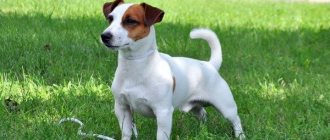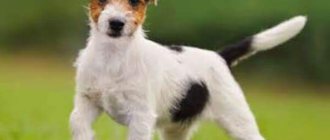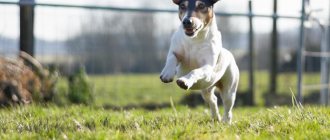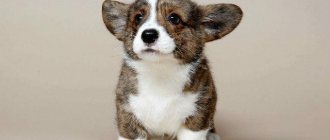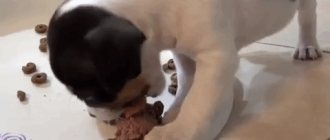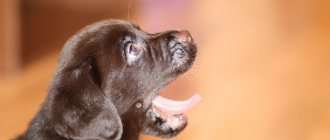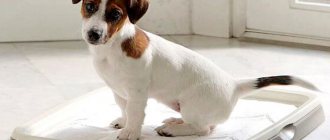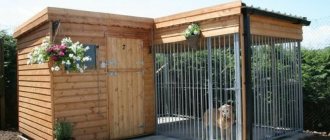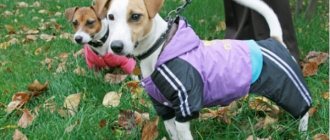How to choose the right Jack Russell Terrier puppy
A potential buyer of a Jack Russell puppy, having started his search, should know that even if the dog is purchased “for the soul” and there are no plans for the pet to have a show career, it is not worth purchasing a baby without documents .
Each Jack Russell must have a document confirming its purebred. A purebred dog not only has a certain set of physical characteristics and a special temperament corresponding to the breed.
These qualities have been cultivated for several decades, and it is only thanks to their combination that the Jack Russell Terrier breed is so attractive and good.
A dog without documents may not grow up to look like a Jack, have a temperament that is not typical for the breed, or have a set of various genetic diseases. Why does the future owner need such a lottery if he wants to buy a cheerful, fearless and charming terrier? Large nurseries or a breeder who has one breeding bitch, when selling babies, must provide the buyer with all the documents he is interested in regarding the parents of the puppy . In addition, when selling a purebred dog, he has a puppy certificate, plus a veterinary passport.
The age of the baby also matters. You cannot buy a one-month-old puppy. According to the rules, puppies are certified by a livestock specialist and a club representative no earlier than forty-five days from the date of birth . After this, the baby is ready to go to a new family, but experienced breeders prefer to raise babies until they are two months or even three months old. Such a dog has already completed a course of vaccinations, shows his inherent character, and a knowledgeable person can easily determine how promising the baby is for exhibitions.
Experienced breeders know that in any litter, among the little Jacks, there are future stars and the most ordinary-looking puppies. Babies that are promising for exhibitions are sold at a higher price . When purchasing, you can ask the breeder what kind of puppy he can recommend, telling you about your expectations and preferences.
Important! Usually, families with small children, as well as beginners, are advised to buy female dogs, as they are calmer and gentler in character. Stubborn, leadership-prone males feel great with an owner who knows how to handle dogs.
How to choose the right puppy? You should not buy the largest baby in the litter.
When Jack Russell Terrier puppies grow up, they will all be approximately the same size; it is more important that the baby has the correct body proportions, bite, and temperament characteristic of the breed. There is no need to choose the smallest dog out of pity.
Too much lag in growth compared to littermates may indicate any problems in health or development.
A small Jack Russell should be cheerful and friendly, actively interested in guests and noisy with littermates. It is impossible to frighten him with a loud sound or confuse him with a new toy. Sitting quietly in a corner, not interested in new people, is either sick or a coward, which a Jack should not be .
In addition to the correct body proportions corresponding to the breed's temperament, the puppy must be absolutely healthy. A shiny coat, clear eyes and skin are signs of health. The baby should be normally developed for his age, have strong limbs, and be fairly well-fed.
Prohibited Products
It is important to exclude prohibited foods from your Jack Russell puppy’s diet:
- Bones, pure fat, skin, especially poultry.
- Palm oil.
- Grapes, raisins.
- Soy.
- Mushrooms.
- Corn and semolina.
- Raw freshwater fish.
- Dry, salted fish.
- Products containing sugar or sugar substitutes.
- Products containing xylitol (chewing gum, some sweets).
- Products containing flour or yeast.
- Products containing caffeine, cocoa, any stimulants (sweets, tea, coffee, chocolate).
- Products containing marinades, salt, spices.
- Smoked products, including sausages, balyki, fish.
- Expired products.
- Leftovers from the table.
Controversial products are:
- Lean raw pork.
- Raw ocean fish.
- Whole milk.
- Honey.
- Chicken eggs.
- Raw and boiled chicken liver in large quantities.
Controversial products can and should be given to a Jack Russell puppy if an allergic or other acute reaction does not occur after taking them.
What price?
Many breeders specialize in breeding certain types of dogs. This requires a wealth of knowledge and special care to maintain the quality of the breed. Even a buyer should know all the physical characteristics of a puppy before deciding to buy it. As a rule, animals from a reputable breeder are registered with a reputable kennel club. In addition, he spends a huge amount of money to provide them. So, the starting price of a puppy with documents from a reputable breeder is 35,000-45,000 rubles. If you decide to purchase a puppy from titled parents, be prepared to pay 80,000 rubles . And if there are not so many championship titles or not at all, then the price is reduced by two or three times.
Puppies without a pedigree can be purchased from 10,000 to 15,000 rubles . If the cost is less than 10,000, then most likely they are offering you a sick dog. Grown-up specimens cost about 25,000, but be prepared to invest in a professional trainer.
Factors influencing growth
It is much easier to ensure the harmonious development of your Jack Russell Terrier if you know the main factors affecting the pet’s height and weight. Their most serious influence is in the period from birth to 1 year of life.
Thus, developmental delay is most often caused by the following:
- Congenital, hereditary diseases.
- Poor quality, insufficient, low-calorie nutrition.
- Poor living conditions - cold, damp, drafts, constant noise, systemic stress.
- Worm infestation.
- Poor living conditions for the mother dog during pregnancy and lactation.
- Untimely, incorrect introduction of complementary foods, too early weaning from mother's milk.
- Insufficient level of lactation in the mother dog during the suckling stage of the puppies' life.
- Lack of supplements of vitamins and microelements necessary for cuties.
- Insufficient or, on the contrary, excessive, debilitating physical activity.
To restore the harmonious development of the puppy, it is better not to let the problem take its course, and not to try to fix it yourself without the necessary education and experience. The best option is to seek help from a veterinarian. Depending on the source of the problem, the solution is found:
- Deviation from the norm during the suckling period. The kitten is placed on the dog's rear nipples, where more milk collects. This situation is typical for multiple litters: stronger puppies push the weaker ones away from the nipples. If there is not enough milk for everyone, then artificial nutrition is introduced and a nurse dog is found. When the puppies are already grown up, with the approval of a specialist, they are introduced to complementary foods ahead of schedule.
- Underweight after purchasing a puppy. Perhaps this is how stress affects the baby - a new home, separation from his mother and siblings. The new owner must surround the baby with attention and care, adjust his diet: add calcined cottage cheese with one yolk, a couple of spoons of whey and 2 drops of a multivitamin.
- Developmental delay is a consequence of helminthic infestation. If the conditions for keeping the animal are ideal, the diet is correct, the reason for the low weight may be helminths. The necessary tests are carried out, the puppies are prescribed Dirofen, Prazitel, Helmintal, etc.
Changing teeth in Jack Russell Terrier puppies
Despite the fact that Jack Russell Terrier puppies mature a little earlier than their larger counterparts, their teeth change at the usual time for all babies.
Already at the age of three and a half months, baby teeth, starting with the incisors, gradually fall out , and permanent teeth grow in their place. If you examine the puppy's mouth at this age, you will see that the front incisors have become very small or are absent altogether.
By four months, the incisors are replaced with permanent ones, the puppy’s canines and other milk teeth gradually become loose and begin to fall out.
It is important not to give the puppy calcium supplements until this time, otherwise changing teeth will be difficult, and the fangs will have to be removed at the veterinary clinic.
Removal of a primary fang is necessary if a new fang is already beginning to grow in its place. In this case, the row of teeth is disrupted, the permanent tooth may grow out of place, resting on the gum and injuring it. If the owner notices the growth of a new tooth, but the old one has not yet fallen out, then before visiting the veterinarian, you can try to loosen the baby teeth . To do this, use large raw beef bones, which the pet gnaws, or practice playing football using an old, deflated soccer ball. The baby, grabbing the ball, digs his teeth into it, painlessly loosening them.
At five months, little Jack's teeth are almost complete. By this age, premolars (small teeth immediately behind the canines) have erupted, and a normal scissor bite characteristic of the breed has already formed.
Vitamins and feed additives
Dogs receiving natural food often suffer from a lack of phosphorus and calcium, as well as vitamins A and D. It is recommended to replenish them with the help of special products for animals. Vitamins are not taken constantly, but in courses - this makes it easier to protect the dog from an overdose.
Remember that the need to use additional vitamins depends on what foods are on the dog’s menu.
The ready-made diet is well balanced; the daily requirement of all vital substances has already been added to it, and additional doses are not needed.
First vaccinations
At 21 days, the puppy and mother are dewormed. This is usually done with a suspension of Drontal Junior, Pirantel and other drugs.
At 4-6 weeks they are vaccinated against distemper and parvovirus enteritis.
At 3-9 weeks the following vaccinations are given:
- repeatedly from plague and parvovirus enteritis;
- from hepatitis;
- from parainfluenza;
- from leptospirosis.
At 12 weeks, revaccination against distemper, hepatitis, parvovirus enteritis, and leptospirosis is carried out. Vaccination against rabies is carried out.
At 6-8 months after changing teeth, revaccination against distemper, hepatitis, parvovirus enteritis and leptospirosis is carried out.
Development by months
At one month the puppy already has its first teeth:
- fangs;
- incisors;
- the first and second false-root ones.
He begins to emerge from his den along with the other puppies.
This is the time when you need to start toilet training your dog. During the first month, the breeder observes an increase in the puppy’s activity and how he gets used to his name. The dog develops a daily rhythm.
IMPORTANT!
At the age of 45 days it is recommended to brand the puppy. At this time, the baby is also already accustomed to hygiene procedures - combing, cleaning the ears and examining the teeth.
The puppy continues to explore the world. Closer to the age of two months, he begins to better remember commands, chew and ruffle objects around him. He is growing and gaining weight, but at this age it is still impossible to see the puppy’s shortcomings.
Further development occurs in the following order:
- At 2-2.5 months, the puppy begins a period of fear. At this time, you need to communicate with him as much as possible and avoid things that would frighten the dog. Also at this time the puppy is already switching to food. At 2 months, the puppy begins to bark and all of his baby teeth appear. This is the right time to start accustoming him to trips and walks. The dog continues to grow and gain weight;
- from 2 to 5 months, the proportions of the dog’s head and body are determined. Character and teeth change;
- at 3 months the dog is already ready for independent life. During these three months, his individual character traits are formed;
- from 4-8 months the dog begins to want to run away from its owner. This is the time for the dog's "sexy" games. The optimal age to move to a new family. The puppy is fully formed and after changing teeth the bite is visible. At this age, the dog’s character, its preferences and habits are visible;
- at 7-8 months the dog’s growth stops;
- at 8-9 months the dog’s teeth finally change. Fangs that have not fallen out need to be pulled out;
- from 6-10 months the bitch begins her first heat and puberty begins. Males mark their territory and raise their paw;
- 6-12 months is a time of fear of new situations. A new trusting relationship is formed between the dog and the owner. During this period, you should not force the dog to approach the object that it is afraid of;
- at 12 months, the dog completes the formation of the “dominance-submission” relationship.
Feeding Jack Russell Terrier puppies: how and what to feed correctly
A Jack Russell Terrier puppy, being very active, needs a complete ready-made food or a balanced natural diet.
When picking him up from the breeder, you should ask what to feed the puppy and what the babies ate.
This is necessary to prevent digestive disorders associated with changes in food and stress from moving to a new family.
Up to three months, a Jack Russell puppy should be fed four or even five times a day . After six months, the pet is transferred to three feedings a day; after a year, the dog is fed twice a day.
Important! Even if the jack ate ready-made food, and the owner is an advocate of eating natural food, then for the first few days the baby should be given dry food, gradually introducing new foods into the diet.
The serving size is determined empirically: the puppy must eat everything that is fed to him, that is put in his bowl. If the food remains, then the portion is reduced; if the dog does not leave the bowl for a long time and licks it, then the amount of food is increased. The daily menu of a puppy receiving natural food must include:
- Raw beef or raw beef tripe.
- Any boiled meat (chicken, turkey, rabbit, beef)
- Porridge made from rice and oatmeal.
- Grated carrots, lettuce, boiled cabbage.
- Dairy products.
- Vegetable oil.
Bitches must be given milk , and a raw egg is added to the porridge once a week. Vegetable oil is added to food in a small amount, about a teaspoon. Many pets are very fond of apples, berries, and nuts - these can be given to the puppy between feedings.
Jack Russell puppies grow quickly, but the low weight and high activity of puppies of this breed contribute to the harmonious development of the dog . A Jack Russell baby does not need chondoprotectors, so the owner can limit himself to the usual vitamin and mineral complex for puppies.
Feeding the Russell
We will not dwell on nutrition in detail, since this has already been written about in our articles. Remember that meat is the primary food of the Jack Russell, and porridge is already in second place. In third place are vegetables and fruits. Follow the sample menu recommended by the breeder; you can change natural food to dry food when the puppy reaches about 3 months.
Adherents of natural feeding say - if you want to prolong the life of your pet, because they are long-lived, feed it correctly. Natural food also promotes the growth of a stronger and shinier coat. In general, the basis for the health of pets is physical activity - walks and nutrition. No matter how much debate there is about different methods of feeding, do not under any circumstances mix “natural” food with dry food, even the most expensive one.
Selection Basics
To choose a purebred, mentally and physically healthy Jack Russell Terrier puppy, you first need to have an idea of the standards of this breed. We recently talked about them in the article “Jack Russell Terrier Breed Standard”.
Take the time to visit as many specialty nurseries or clubs as possible. There is no need to buy a baby in dubious stores and markets, without documents. But you shouldn’t take a puppy from the very first kennel. Of course, every seller will captivatingly describe the merits of their clients, but these words do not always correspond to reality.
It should be noted that many breeders keep real pedigree puppies for themselves, that is, those who have a full set of characteristics for a future exhibition career and breeding. They are trying to sell worse babies. That is why always carefully examine the babies.
Dogs without a pedigree may have hidden defects that will appear much later, when the puppy has already become a full member of the family.
After completing important steps, you need to carefully examine the droppings and the place where they are kept.
What problems might arise?
First of all, there may be a mess in the house, but if you prepare in advance for the arrival of an important guest - a puppy, you will avoid many problems. According to the recommendations of experienced breeders, you need to raise the curtains up. Because the “little monkey” will start to rattle them until a sieve appears in them.
Also, tidy up everything small so that the dog does not swallow objects, wires and carpets, so that during toilet training they do not become the same toilet. Take care of the floors, figure out how to cover them to prevent them from slipping, because the jack moves very quickly around the apartment and can dislocate his joint. By the way, the health of the Jack Russell is very good, but the joints and eyes are a special issue, these parts of the body must be protected . Do not lift the puppy up by its paws under any circumstances, this is very dangerous.
This puppy is not one of the shy ones and will soon adapt to its new home, but it needs supervision. We hope you have already prepared a place where Jack will spend his holidays and, in case of misconduct, serve his sentence... this could be a house, a bed or even a cage. If you stop at the third, take care of the spaciousness of the enclosure.
An aviary is needed so that Jack, due to his energy and curiosity, does not spoil expensive things. There have been, and still are, cases of Jack Russell literally gnawing concrete corners. How does he do this, you ask? It’s just that Jack has sharp and strong teeth, and when they change, they itch a lot. It is useless to scold the dog for this, she will outgrow her age and everything will return to normal, she will simply not be interested in it, and her teeth will be in perfect order.
In order to protect their corners, closets and the entire apartment, some breeders believe that it is better to install an enclosure right away; others believe that this is discrimination against the dog. If you have already decided to have a pet, you need to educate it, and not put it in a cage, and in this case you will have to forgive the tomboy, and subsequently make repairs.
Another problem that may arise is hand biting, what to do when a dog bites? You need to carefully pull your hand back and hide it, then say the word “no” or another command that prohibits bad behavior. The dog may not listen to you and persistently search for your hand, then you need to give it a toy to chew on or a cartilage bone. It is absolutely forbidden to allow cheeky behavior.
Care and maintenance of Jack Russell puppies
Features of care
Jack Russell puppies are strong and healthy; babies of this breed do not need labor-intensive and expensive grooming, but the owner must carry out the following procedures regularly:
- Eye care . Wipe your eyes in the morning using a dry cotton pad or a regular paper napkin. A healthy puppy has almost no discharge from the eyes, so he does not need to use special solutions.
- Ear care . The ears are wiped once a week, cleaning the shell with a cotton pad soaked in a solution of Chlorhexidine.
- Grooming . _ The coat of a smooth-haired baby is combed with a special brush, which not only removes loose hairs, but also gently massages the skin.
- Paw care . Your pet's nails wear down naturally when he walks a lot on hard surfaces. Walking on gravel or asphalt helps strengthen the ligaments and wears down the claws. But if the claws grow so long that they interfere with the puppy’s walking, he begins to lame and the posture of his limbs is formed incorrectly. The claws are trimmed with a special guillotine, trying not to touch the nerve and blood vessel located just above the edge.
Content Features
The Jack Russell puppy is stubborn and able to make decisions on his own, has a wild temperament and requires as much attention as possible . Dogs of this breed cannot live in an enclosure or on the street, are not able to sit on a chain and love comfort. Apartment housing implies early training in neatness, and the puppy must be trained to use the toilet outside, without waiting for the end of the vaccination quarantine. Otherwise, the stubborn terrier will make puddles indoors for a very long time, and it will be difficult to wean him from this habit.
Walking and playing are little Jack's favorite activities . A puppy of this breed has enough energy to pester family members for many hours with a toy in his mouth, to strive to track down and catch up with the neighbor's cat and to eat any garbage. The kid will dig huge holes in the flower beds, tear at the bushes and try to tear the canopy over the swing in the garden, and also start quarrels with his fellow tribesmen on the playground.
The owners of a puppy of this breed can only dream of peace, since the pet requires almost round-the-clock attention . To prevent damage to things, as well as for the safety of the puppy itself, you need a crate where the baby will spend time in the absence of the owners. By locking a pet in it, owners can be sure that the fidget will not chew electrical wires or damage the upholstery of upholstered furniture.
Important! A crate for a Jack Russell puppy is a cozy home with a rug and toys, not a prison.
When walking, it is better not to let a puppy of this breed off the leash, as he may get carried away chasing a bird or a cat or get hit by a car. A roulette leash is perfect for walking, the length of which is automatically adjusted.
Teaching first commands
After the puppy has acquired the basic skills, it’s time to learn the simplest commands. The Jack Russell baby is ready to train at the age of 6 weeks. The commands you should start training with are presented in the table below along with the age at which they are easiest to learn.
Table 2. Study of commands from 6 weeks to 6 months of age
| Puppy age | Team | How to train |
| 6 weeks – 2 months | Puppy's name | The nickname should be called every time you contact your pet and rewarded if he responds to his name |
| 2-3 months | "To me!" | The owner shows the dog a treat held in his palm and calls him to him with a gesture |
| 3-3.5 months | "Lie!" | The treat is placed in front of the dog. If she does not lie down, gently help her by pressing on the croup. |
| 3.5-4 months | "Ugh!" | The owner says “Ugh!” when the puppy grabs garbage from the ground while walking. In case of disobedience, the command is repeated more strictly. If during a walk your pet wanders off to the side, you need to say “Ugh!” and pull the leash towards you |
| "Sit!" | The trainer holds a piece of treat above the puppy's head so that he can notice it only after he sits down. | |
| 4-6 months | "Near!" | During walks, the puppy is kept on a leash near the owner's left leg. At first they teach to sit and stand next to the owner, and then |
It is recommended to learn no more than two commands in one lesson. Each order must be repeated constantly so that the puppy does not forget the commands. This course is designed so that the child gets used to training gradually - from simple commands to complex ones. A new command should be given to the pet to study after the previous one has been reinforced.
Important! After the owner has shown the pet the action for the command and announced its name, nothing can be changed. Otherwise, the puppy will get confused and will not follow orders.
Upbringing
There are 3 types of training: burrow hunting, searching for wounded animals, game hunting, including pursuit on the ground. Owners themselves decide which is preferable for their plans. Training begins at 8-10 weeks of age and takes place in a playful way. With age, classes become more difficult.
- They build obstacles and use incentives. The animal is characterized by temperament and unconditional obedience must be curbed.
Self-confidence, pressure, activity are manifested from a young age. If you let your pet's life take its course, it will educate itself.
The result will be damage to furniture, shoes, carpets, books, and cords. Holes will form in the sofas, and the Internet, TV and washing machine will stop working. Become the leader of the pack, the dog will obey the leader.
Training for hunting
To engage your pet in hunting, he is taught not to be afraid of loud noises.
To do this, you will need an assistant who will shoot from the scarecrow. First, the assistant moves away to a distance of about 150 m. Gradually the distance is reduced. If the dog gets scared, breaks from the leash, or tries to hide, the owner calms it down and shows with all his appearance that everything is in order. In total, the training takes 3-4 days. Subsequently, the animal is taught:
- fetching;
- come on the whistle;
- work on game.
Starting from six months, you can carry out special training - baiting on a burrowing animal.
What to buy for a Jack Russell Terrier puppy
Before purchasing a puppy, you need to buy a few essential things for him . The baby will need:
- Two bowls, preferably on a stand. The naughty boy will turn over floor bowls while playing with water.
- A soft rug, bed or foam house.
- Small soft collar and roulette leash. It is better to immediately take a leash based on the weight of an adult jack. The harness is purchased only after trying it on.
- Soft and rubber toys, squeakers and balls, a whole beef bone. The sinew bones are too hard for a small puppy, so he won't play with it.
- A large crate designed for an adult dog.
- If you adopt a puppy during the cold season, then you need to buy or make a warm blouse or overalls for him.
The list of things a dog needs will eventually be replenished with hypoallergenic shampoo, a rubber brush, vitamins, new toys and new things. Your puppy will need tick repellents, various treats, and a brush to help care for his teeth.
Features of care
Before the puppy comes into your home, prepare the space - remove small objects and wires, as well as other things that could harm the baby, from visible places. Remove personal and expensive items that could be damaged.
Prepare a place for the puppy. There should be no drafts, windows, or heating objects near it. Try to make it a place where the dog is at peace. If you need to isolate your baby for a while, use a playpen, cage or enclosure.
As soon as the puppy appears in the house, show him who is the boss. Designate an area where he can play, sleep, eat, and where he should stay away. It is better not to retreat from such tactics. Raise your puppy from the first days, while he is still trainable.
There should always be toys in the Jack Russell's personal place that will distract him while you are busy with your business or while you are relaxing.
Train him to toilet in a timely manner - usually after sleep or after eating. Buy a special diaper at a pet store. As soon as you notice the puppy’s anxiety, show him a place to relieve himself.
After the required vaccinations, you can accustom the puppy to the street. To do this, use an already used diaper - the dog will react to the smell.
The first walks should be no more than 10 minutes. As the puppy grows, increase the time. Even if the weather is bad outside, be sure to take the puppy out, at least so that he can go to the toilet.
Don't forget to play active games with your puppy during walks. Stop your puppy from chasing other dogs and cats. Teach him discipline.
Brush your puppy several times a week. During molting season - daily. Puppies with long hair will have to be taken to a grooming salon. Teach your baby to behave calmly during hygiene procedures.
NOTE!
Don't forget to clean your puppy's ears and trim his nails. If necessary, rub your eyes. To care for your teeth, purchase a special brush from a pet store.
You can bathe the puppy after scheduled vaccinations, when two weeks have passed. This breed does not need to be washed frequently, but only with special shampoos. On average, Russells are bathed three times a year.
Read about other features of Jack Russell care here.
Useful video
In this video you can watch a video about Jack Russell Terrier puppies.
The happy owner of a Jack Russell Terrier puppy must understand that he is responsible for how his dog will grow up . Proper feeding and purchasing the best vitamins and the most beautiful collars cannot replace a dog’s many hours of daily walks.
Only during joint games or training does mutual understanding and friendship, respect for the owner, and recognition of his leadership arise and strengthen.
Brief information about the breed
Dogs of this breed were bred in Great Britain for burrowing . The breed combines small size, strength, courage and powerful jaws. All this was needed to penetrate the hole and grab prey.
NOTE!
The breed is named after the English pastor John Russell from Devonshire. He was very fond of horse hunting, and it was he who first described these dogs.
Nowadays, the Jack Russell Terrier has an average weight of 5-7 kg, and a height at the withers of 25-31 cm. The skull is slightly narrowed towards the eyes. The eyes themselves are shaped like almonds, dark and deep-set. The chest has a girth of 40-43 cm, the tail is docked. The life expectancy of dogs of this breed with proper care is on average up to 14-15 years.
From the first days, Jack Russell Terrier puppies are characterized by excessive activity and a desire to dominate their owner, therefore, in order to turn a Russell into a well-mannered dog, you will have to make a lot of effort. Raising a Jack Russell should take place without shouting and beating, but at the same time without indulging in all the dog’s pranks, which will turn the puppy into a real little devil in the future.
To prevent bad behavior, you need to stop any antics of your pet, not be touched by his pranks, and not allow the dog to become the main one in the house and manipulate you.
When to pick up
If you plan to participate in various exhibitions or breed Jack Russell Terriers, then you should not pick up the puppy from the kennel before four months. Ideally, it is best to take your baby home when he is six months old.
At this age, it will become clear what size, bite and other features your pet has. In addition, he will already have basic parenting skills - accustomed to cleanliness, adapted to the world around him. It also becomes clear what kind of character the Jack Russell Terrier has.
By purchasing a dog ahead of schedule, you risk not noticing any flaws, both psychologically and physically.
Conditions of detention
A bed for a small Jack Russell should be located in an area away from drafts and heating devices. A playpen or cage is best. For the dog’s comfort, a mattress with a changing pillowcase is placed on the bed. The baby should also be provided with toys. Toys made of latex or wood are recommended, without small parts, because... the animal bites and can swallow small items.
